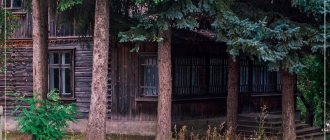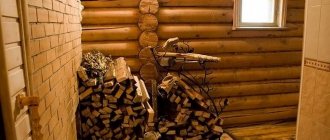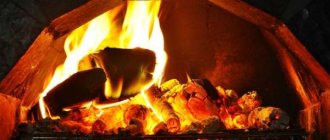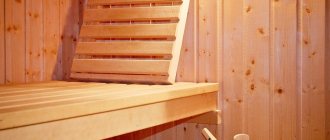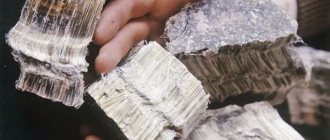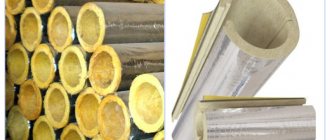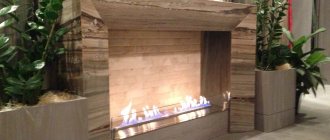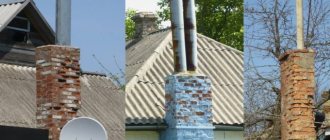First, it will not be superfluous to understand the material itself. So, today the industry knows chrysotile asbestos and amphibole asbestos. They are very similar in structure and both materials are obtained from mountain flax fibers. What we are used to using as protective thermal pads, dielectrics and even pipes for laying cables belongs to the white mineral of the serpentine group, that is, chrysotile asbestos. By the way, the pipes are called “chrysotile-cement”. The material cannot be classified as an expensive product, but, nevertheless, people often search on the Internet for what can replace asbestos - I will try to answer this question.
Source facenews.ua
What can replace asbestos?
As I understand it, you want to replace asbestos-cement facade slabs with something similar in characteristics.
There are many options here, for example, not bad, fiber cement boards for finishing facades.
An absolutely environmentally friendly material, consisting of 90% cement and sand, the remaining 10% fiber (reinforcing material).
These slabs can be produced in various versions, that is, they look like something (for example, imitation stone, brick) or simply smooth.
The material not only does not support combustion, but is also a barrier to fire (like asbestos boards).
Thanks to the fiber, the slabs are durable and can withstand significant mechanical loads.
They are not afraid of temperature changes, UV radiation, and so on, that is, the properties are similar to asbestos boards, but at the same time environmental friendliness is at a different level.
The slabs do not rot, are not subject to corrosion, and are water resistant.
The price is quite affordable.
The choice of colors is simply huge.
What to put on the floor under the AOGV hot water gas boiler?
An AOGV gas boiler is installed in the kitchen.
Firefighters require that a sheet of iron or ceramic tile be placed underneath it. The size of the tile should be 75 by 60 cm. I can’t find such porcelain tiles anywhere. Moreover, if you assemble it from small tiles, then you need to put it on glue, and the base is plywood (since I prepared it for linoleum). I want to cut a hole in 12mm plywood and put a slab there, but then it turns out that the thickness of the tile is 15mm. Maybe you can come up with something else, please tell me? Best answer
Cut from ATSEID (aceite, aceid) to size. Sheets come in thicknesses from 6 to 40mm. I think firefighters will not be against asbestos-cement electrical arc-resistant boards. At least decorate it with mosaics)))
Other answers
You can screw GVL or GKL to your plywood in 2 layers. Place any tile on it with glue. Due to the height, you will get a podium. Cover the end of the podium with tiles as well. With good tiles, the podiums look very good.
I had the same problems, I made a podium from ordinary floor tiles in the color of Lenolium - it turned out great
How to replace asbestos
Asbestos can be replaced:
The fabric will be very effective in extinguishing fires and substances that cannot burn without oxygen. This is a strong, durable, wear-resistant fabric that can protect well from fire without losing its characteristics at high temperatures.
This material loses the classic transparency of glass, but acquires good acoustic and thermal insulation qualities. It is so hard that you can drive a truck on it.
It is often used for thermal insulation of load-bearing walls, pipelines, and basements. Despite its high rigidity, foam glass is easy to process.
Each insulation has its own characteristics and is an improved version of mineral wool. Glass wool is quite heat resistant, it can withstand temperatures up to 450 degrees.
Basalt wool can withstand thermometer readings up to 700 degrees. Slag wool is less resistant to heat and can withstand up to 300 degrees Celsius.
Asbestos is widely used for insulation of various structures. However, it is harmful to health, so people often wonder what can replace asbestos.
Today, several common materials are used for insulation, which are practically not inferior to asbestos in their characteristics, sometimes they are even better.
Asbestos fabric
This material is a safer option than regular asbestos. Only asbestos dust, which penetrates into the lungs and causes various diseases, can have a negative effect on the body. Therefore, when working with such fabrics, you need to adhere to safety precautions, otherwise find another material.
To reduce the negative impact of the fabric, it can be painted or covered with film. It is also best not to place asbestos fabric in areas with good air circulation. The main advantage of this material is that it is able to retain all its characteristics even at the highest temperatures.
Foam glass
The material has many advantages over its analogues. The only disadvantages include high cost and low impact strength. However, these disadvantages are not critical and do not outweigh the advantages.
Foam glass can often be seen as backfill in wall cavities or as an insulating additive to concrete.
It is also used in industrial refrigerators and various equipment that operate at high temperatures.
Roll insulation
When using roll insulation based on mineral wool, it is important to consider the surface and purpose of the material. Some options are best used for wood, others for brick or concrete.
It is also important to take into account the thickness of the base, temperature and weather conditions, especially if the insulation is external. Overall, this is a quality option with a lot of advantages.
There are many options for replacing asbestos. However, it is better to choose only proven, high-quality analogues. When choosing insulation, take into account its characteristics and the possibility of using it in certain conditions and the result will definitely please you.
Asbestos substitutes
Asbestos papers and cardboards are used as sealing and filter materials for cleaning liquid media. High surface activity and small sizes of needle-shaped crystals (and, accordingly, small effective pore sizes) allow high-quality purification from impurities. However, currently non-woven materials based on ultra-thin chemical fibers are used for this purpose, which have largely replaced asbestos.
Asbestos fabrics have served for many years as thermal insulation materials, material for sewing protective clothing for firefighters, capes and other technical needs. However, they are inconvenient to use - they wear out quickly. Today, protective equipment (primarily suits) based on multilayer bags, including polymer heat-resistant fabrics with heat-protective layers, aluminized on the outside to achieve high reflectivity, are widely used for these purposes. Suits for working in extreme conditions when exposed to open fire today are complex designs that allow long-term work in contact with an open flame. Thus, the use of asbestos for these purposes is already an anachronism.
Sealing cords for shafts and other moving parts have traditionally been made from asbestos in combination with other types of fibers. Today, they have been successfully and more efficiently replaced by textile structures made of carbon and fluorine fibers, which are more reliable and durable in chemically aggressive environments.
Asboplasty. In structural asbestos plastics, asbestos fibers (asbestos fiber), papers (asbogetinax) and fabrics (asbestos textolite) are used as a reinforcing component. The binders in asbestos plastics are usually thermosetting resins - phenolic, melamine-formaldehyde, etc., as well as thermoplastics.
Various parts or products are made from thermosetting asbestos plastics, including electrical insulating parts and products for low-voltage equipment, friction products (brake linings and pads), parts of chemical equipment (for example, pump rotors) and others. Asbestos fiber concrete (faolite) is used for lining equipment. Asbestos textiles are used mainly in electrical products. These materials are currently losing their importance and are being replaced by glass or carbon fiber reinforced plastics. A widely known material is sheet paronite based on asbestos fibers, other fillers and rubbers, used for sealing gaskets. Today it is successfully replaced by materials containing carbon and aluminum oxide fibers.
Pre-treatment of synthetic fibers
(increases the coefficient of utilization of reinforcing properties and the degree of adhesion to cement stone)
- pass between the corrugated rollers;
application of ring deposits of polymer adhesive based on epoxy resin.
Use in asbestos cement
paper and cellulose fibers
When comparing cellulose and asbestos fibers, it should be noted that cellulose fibers subjected to grinding (fluffing) have a significantly greater length compared to fluffed asbestos fiber. The pulp mass is very homogeneous and has a significant degree of fibrousness.
VNII Project Asbestos Cement, together with the Krasny Stroitel plant, has developed a technology for the production of asbestos-cement sheet products with the introduction of up to 3 - 5% of paper fibers (by weight of asbestos). With such a quantity of paper fibers, the plastic properties of the semi-finished product are improved and the impact strength of the finished products increases.
The filtration properties of asbestos-cellulose suspensions improve when cellulose is added up to 6%, and the recovery coefficient increases. With a higher input, the catchability coefficient practically does not change, the static strength of the products and their volumetric mass decreases, and water absorption increases accordingly.
To improve the adhesive properties of cellulose fibers (relative to cement), CaCI 2 and CaO are added to the suspension in an amount of 0.5 - 1.5%. As a result, the bending strength of the products increases significantly.
To prepare paper pulp, hydropulpers are used. The paper grinding process lasts 3-4 minutes. Then the finished suspension is pumped out by a pump into a storage tank, in which the suspension is further diluted with water to a concentration of 22 - 26 g/l. To prevent the paper suspension from stratifying in the storage container, air bubbling is carried out. From the storage tank, the paper suspension is fed through the dosing tank into the mixing apparatus.
How to replace asbestos in a sauna stove?
It depends on which unit (where) the asbestos needs to be replaced.
For example, instead of the asbestos cord that is used in chimneys (sealing pipes), you can use this heat-resistant sealant, which can withstand temperatures up to 1200 degrees, and does not contain asbestos.
The same sealant can be used for repair work in the furnace, sealing cracks, crevices, and so on.
If you need a material that will protect the wall near the stove from fire (for example, now you have sheet asbestos there), then you can use this material GKLO, which means plasterboard is fire-resistant and does not contain asbestos.
Also, instead of asbestos, you can use protective screens, for example, made of stainless steel (sold as a finished product).
Superizol (calcium silicate, sheet material) is also a worthy substitute for asbestos. Minerite-Sauna (sheet), another option, specially designed for shielding stoves in saunas and baths, also does not contain asbestos.
Where is asbestos used?
Asbestos is another name for mountain flax. It is a fine-fiber material. Asbestos is valued for its high heat resistance and strength. It is not afraid of the release of vapors, gases and solar radiation.
The main types of asbestos are crocidolite (blue asbestos) and chrysotile (white asbestos). Other varieties are amosite, anthophyllite, tremolite and actinolite.
This material is actively used in the following areas:
- Industrial and general construction . Construction companies use asbestos boards when installing wall panels or floors;
- Chemical industry . Some plastics and paints contain asbestos particles;
- Manufacturing of certain types of workwear . The high strength characteristics of asbestos make it possible to use it in the creation of protective gloves and tight suits;
- Fire show, fireworks, firecrackers . Asbestos fabric is used to wrap the wicks of props intended for spectacular fire performances.
What is made from asbestos: list
The list of products that may contain asbestos is quite large:
- Roofing and wall products. For example, asbestos is used to create sheets of slate and foam concrete;
- Plates for facades;
- Water pipes;
- Fireproof fabrics;
- Non-flammable asbestos cardboard (asbestos cardboard);
- Bricks;
- Fire curtains and doors;
- Thermal insulation (asbestos wool, foam asbestos);
- Brake bands;
- Rubber products;
- Silicate coatings;
- Vinyl Floor Tiles;
- It is used in the automotive industry, for example, it is part of the materials from which brake pads are made.
- Mastics, sealants, construction drilling fluids, putties and mixtures;
- Many other products where thermal insulation, fire resistance and flexibility are required.
Russia is one of the leaders in asbestos mining. Next comes China. Brazil and Kazakhstan are a little behind the Celestial Empire in this regard.
Scope of application
Asbestos is used in the production of a wide variety of materials. Today, more than three thousand types of products are known that contain this mineral.
Construction. In construction, the properties of chrysotile-asbestos such as strength and fire resistance are used. Asbestos boards are a popular building material. In addition, asbestos fibers are found in some flooring and roofing materials. Asbestos wool is used as a thermal insulator.
Mechanical engineering and metallurgy. Due to its fire-resistant properties, asbestos spraying is often applied to cables and various structures made of steel and concrete. Asbestos-cement pipes are used in sewer, ventilation and pipeline systems of industrial enterprises and residential buildings. Such pipes are highly durable, but since there is a possibility of asbestos vapors entering the living space, today they are used less and less. Nevertheless, asbestos gasket materials are still widely used in mechanical engineering and ferrous metallurgy to this day.
Chemical industry. Chrysotile is widely used in the production of various plastics, asbestos-rubber sheets, asbestos-bitumen and asbestos-resin products. In addition, it is used in the production of paper, varnishes and paints. Chrysotile is often used in the manufacture of thermal insulation materials and the production of products with a high degree of resistance to alkalis and acids.
Textile industry. Asbestos of groups 0 - 2 is called textile, as it has long fibers. In combination with cotton, it is used to produce workwear - fireproof suits, aprons, gloves, helmets. It is also used to make fabrics for turbo generators, drive belts, brake bands and gasket seals.
Today it is difficult to imagine industrial production without materials based on asbestos fibers. Thanks to its unique chemical and physical properties, it confidently entered our lives and to this day occupies a strong position.
How dangerous is asbestos for humans?
The first assumptions about the dangers of asbestos appeared half a century ago. In Finland, this material was mined at one of the largest mines in the 1970s. Male mortality among the local population was quite high. On average, men here died 10 years earlier.
According to medical statistics, many of the dead were mine workers and almost all had lung cancer. Finnish authorities decided to close the mine.
It was later discovered that asbestos dust has carcinogenic properties. When working with asbestos, the worker inhales its particles, and they quickly penetrate into the lungs. However, the body cannot get rid of them. Asbestos gradually accumulates in the lungs, leading to the development of inflammation and cancer.
International studies have proven that asbestos is classified as the most dangerous carcinogen and its negative impact on the lungs has been fully proven. That is why the production of this building material was banned in European countries.
Amphibole asbestos is especially dangerous. It poses a health hazard even if the material is not sprayed.
White asbestos or peridot is not as dangerous and is still quite common in various areas of construction. Mixing it with cement does not produce toxic fumes.
When constructing some objects, it is better not to use white asbestos. For example, if it is used in the construction of a bathhouse, the material will begin to crumble under the influence of regular heating. This already leads to the spread of asbestos dust in the room.
If you still have to work with asbestos, the following rules should be observed:
- Do not spray asbestos into the air;
- Do not use fragile products;
- Construction asbestos waste is placed in special bags and disposed of;
- When removing an asbestos roof, work clothes are worn, which it is advisable to then throw away. Experienced builders also recommend pre-moistening the dismantled slate with water.
In the USSR, asbestos was a fairly popular building material. For example, Soviet asbestos slate still lies on about 30% of residential buildings.
Let's sum it up
Asbestos-cement sheets are popular in the construction industry, the technical characteristics of which allow the material to confidently compete with other types of roofing building materials. In specialized stores, sheet asbestos cement is presented in an expanded range, which makes it easier to select the required assortment of asbestos cement to solve specific problems. When purchasing sheets, decide on their standard size and, if necessary, consult with professional builders.
Sources:
https://www.remotvet.ru/questions/13338-chem-mozhno-zamenit-asbest.html https://mastergrad.com/forums/t172653-asbestovaya-plita-asbocementnaya-ili-chto-to-eshche/ https ://1beton.info/vidy/asbestocement/asbestocementnye-listy https://garant-torg.ru/asbestotsementnye-listy-sfera-primeneniya-osnovnye-harakteristiki-i-dostoinstva/ https://pobetony.expert/poleznye- stati/listy-asbestocementnye
What building materials are best to replace asbestos?
Today there are several more modern and safer materials that are not inferior in quality to asbestos. The International Labor Organization suggests using the following building materials to replace asbestos:
- Metal tiles or corrugated sheets. An excellent alternative to asbestos slate. In addition, both materials are even stronger than asbestos;
- Basalt slabs. They can replace asbestos boards; they also withstand elevated temperatures well;
- Minerite. It is mounted between the stove and the walls in the bathhouse. Minerite does not rot and can withstand temperatures even at 600°.
Asbestos cement sheet - technical characteristics
- strength of wave sheets - 18 MPa;
- flat - 23 MPa;
- weight of wave material - 1.6 g/cm3;
- flat - 1.8 g/cm3;
- viscosity of the pressed product - 2.5 kJ/m2;
- unpressed - 2.0 kJ/m2;
- freezing and thawing of pressed slabs - 50 cycles;
- unpressed - 25 cycles.
Plates and sheets are resistant to corrosion, are not afraid of rotting, and resist UV rays and chemicals. When products are coated with waterproof enamel, they become resistant to water. Water absorption is comparable to glazed ceramic tiles.
Does asbestos cause cancer?
Today there is no longer any doubt that asbestos causes cancer . This fact has been confirmed by the International Agency for Research on Cancer.
All types of asbestos are carcinogenic to humans. Exposure to asbestos, including chrysotile, causes cancer of the lung, larynx and ovaries, as well as mesothelioma (pleural and peritoneal cancer). Asbestos exposure is also a cause of other diseases such as asbestosis (pulmonary fibrosis) and pleural plaques, thickening and effusion.
But here it should be borne in mind that for the disease to develop, asbestos dust must enter the lungs. People who directly work with this material are at risk.
If safety precautions are not followed, they inhale asbestos dust, which causes:
- Pleural mesothelioma. Type of oncology;
- Asbestosis. Pulmonary fibrosis, which often resolves without visible symptoms. The progression of asbestosis is accompanied by cough and shortness of breath, sometimes the patient feels tired;
- Chronic pulmonary diseases.
Despite the dangers of asbestos, it is still used as a building material. For example, in Russia slate is made from it and used in mortars. The most carcinogenic amphibole asbestos is being phased out all over the world.
Video: negative properties of asbestos dust
In this video, chemist Andrei Bavarov will tell you in what materials asbestos is used and what types of it are dangerous to human health:
Harm to health
Many studies have been conducted until it has been scientifically established why this material is harmful to humans. The danger comes from inhaled asbestos dust, which is formed when objects made from it are destroyed. Prolonged inhalation of such dust can cause bronchitis and asbestosis (silicatosis) - the formation of scars on the tissues of the respiratory system due to the accumulation of settling asbestos particles. There is evidence that with prolonged exposure to the body, asbestos causes cancer.
There is a theory that asbestos-cement sheets are not harmful during normal use, but arise only when heated. Due to the fact that the material does not burn, it is often used for the production of products exposed to high temperatures. The question arises as to whether asbestos sheets are harmful when heated. When heated, the material emits vapors of harmful substances, so it is better not to use it in the construction of baths. The consequences of asbestos poisoning can take years to become apparent. For asbestos-cement (aceite) sheets, the harmfulness is reduced by carrying out a number of measures, for example, painting the products.
Due to the fact that sheet asbestos, a material often used in construction, is harmful to health, many today are thinking about replacing it with more environmentally friendly analogues. The question of what can replace asbestos sheets is not an easy one, since this raw material has also gained popularity due to its cost-effectiveness.
Exact analogues of this material have not yet been found, but there are substitutes:
- In electrical engineering, asbestos cement is replaced by various plastics, for example, fiberglass.
- Asbestos-cement products are replacing materials made from basalt, carbon, and aramid fibers.
- Due to information about the dangers of asbestos when heated, asbestos fabrics, which for many years served as the main material of protective clothing, are being successfully replaced with heat-resistant polymer ones.
- Asbestos sealing cords for moving parts have given way to textile structures made of fluorine fibers.
- Glass and carbon plastics have replaced asbestos plastics in the production of electrical insulating parts.
Today, the chrysolite mineral is recognized as relatively safe. The main factor for its harmless use is complete control of use:
- High density of the products used, preventing excessive crumbling of the material.
- Dispose of dust in sealed containers.
- Measuring the level of asbestos fibers in production.
- Multiple coating of partitions and panels.
- Regular wet cleaning and disinfection of premises.
- Systematic medical examination of workers.
Subject to sanitary standards and necessary precautions, the harm of asbestos to humans can be minimized.
When are sheet fireproof materials used?
It is not always necessary to use protective materials, but only in cases where the fire-safe distance from the stove surface to flammable objects is not maintained. If the distance is large enough, the wood does not heat up enough to cause a fire.
For a spacious room, such requirements are quite feasible. But in a small home steam room it is not possible to provide a distance of 1 m. Therefore, fire safety can only be achieved with the help of fire-resistant screens and cladding.
Asbestos cement sheet - technical characteristics
When planning to use asbestos cement sheet, the technical characteristics should be carefully studied.
Main product indicators:
- ability to withstand bending loads. The strength indicator varies from 18 MPa for corrugated material to 23 MPa for flat asbestos cement;
- specific gravity. The density of the sheets differs depending on their type and is 1.6 g/cm³ for sheets with a wavy surface, and 1.8 g/cm³ for flat material;
- impact strength coefficient. Asbestos cement obtained by pressing has the highest value, equal to 2.5 kJ/m². The unpressed material has a reduced impact strength value of 2.0 kJ/m²;
- ability to maintain integrity under the influence of temperature changes. The pressed material is capable of withstanding at least 50 cycles of deep freezing with further thawing. For other types of sheet cement, the figure exceeds 25 cycles.
The residual strength for all types of sheets is at least 90 percent.
Before using asbestos cement sheet, you should carefully study the technical specifications
Protective screens for furnaces
Protective screens are structures used to insulate the side walls of furnaces. They reduce thermal radiation. Protective screens are made of brick and steel. Mostly such designs are used for metal furnaces.
Oven with metal protective screen
The easiest way to build a protective screen for a furnace with your own hands is from sheets of cast iron and industrial steel. Such screens are the most common. The sheets are installed at a distance of 1-5 cm from the walls of the oven.
Screens can be either side or front. There are furnace designs that do not require protective screens. They already have a special casing that reduces the intensity of thermal radiation.
Thanks to the use of protective screens, the temperature on the external surfaces of the structure reaches no higher than 100 °C . This significantly increases fire safety and reduces the distance from the screen to the wall of the room to 50 cm. Taking into account the gap between the screen and the oven wall, the safe distance does not exceed 55 cm. Protective screens are convenient and easy to install. With the help of special legs they are securely attached to the floor.
Fireproof wall coverings
If the wall of the room is directly adjacent to the surface of the stove, this leads to excessive heating of the wall, which can cause a fire. To avoid fire, the walls are sheathed with non-flammable materials.
Reflective lining
Good results are achieved by cladding that combines non-flammable thermal insulation materials and metal sheets. First, thermal insulation is attached to the wood of the wall, and sheets of metal are installed on top of it. For the outer layer, either stainless steel or galvanized is used. However, from the point of view of environmental friendliness, it is better to take stainless steel , since there is evidence that when heated, galvanized steel begins to release toxic substances.
To make the resulting cladding more effective, the steel sheet must be polished to a mirror finish. In this case, heat rays are reflected from the metal, and the wall heats up even less. In addition, the steam room receives reflected heat flows, which are softer and more acceptable to humans than those that come directly from the stove.
A number of thermal insulation materials are used for cladding:
- basalt cardboard - thin sheets of basalt fiber. This fireproof material provides not only good heat but also sound insulation;
- asbestos cardboard is a material with high thermal insulation properties. It is also fire-resistant, durable and strong;
- mineralite is a fire-resistant material from which sheets are made, used for installing protective screens for stoves and fireplaces, including in steam rooms.
The general scheme for using sheathing looks like this: wall - gap (2-3 cm) - thermal insulation (1-2 cm) - sheet of metal. This allows you to reduce the distance between the stove wall and the wall of the room to 38 cm.
The gap in the described circuit is ensured by ceramic bushings that do not heat up. If the room does not allow even the specified minimum distance between the stove and the wall to be achieved, the cladding is made with two layers of thermal insulation. A gap of 2-3 cm is left between them using ceramic bushings. Stainless steel is attached on top of the outer sheet.
Cladding with cladding
To give the steam room a more aesthetic appearance (bare iron on the wall does not look very attractive), the walls can be covered with ceramic tiles. However, if it is placed directly on wood, there will be no insulation. Therefore, the following cladding scheme is used: wall - gap (2-3 cm) - fire-resistant layer - tiles. In this case, it is allowed that there be at least 15-20 cm between the wall of the stove and the wall of the room.
Wall cladding with cladding in the bathhouse
The following materials are used for the fireproof layer:
- Fireproof drywall is drywall that has fiberglass added to it. This material is not afraid of thermal radiation and does not deform under its influence;
- mineralite is an effective fire-resistant material. Minerite fireproof boards are characterized by high moisture resistance, do not collapse or rot;
- glass-magnesium sheet is a material made from fiberglass. Magnesium substance is used as a binder. It has good sound and heat insulation, resistance to moisture and temperature changes.
The gap in the described circuit cannot be neglected, since it plays an important role. Its presence allows you to reduce the heating of a wooden wall to a minimum. The use of cladding makes the steam room look more attractive and makes it possible to maintain the design in the chosen style.
Wall cladding with sheet refractory material (PVTN)
Properly selected material for wall cladding ensures high fire safety of the room. One of the most effective for achieving this task are vermiculite panels. Vermiculite fire-resistant boards for walls are widely used to ensure fire safety of various types of premises. Their reliability is so high that this material is used in the nuclear and oil refining industries.
Advantages
The use of fire-resistant vermiculite boards allows achieving high levels of:
- environmental friendliness;
- fire resistance;
- thermal insulation;
- soundproofing;
- aesthetics.
The last point is especially worth noting. Experts know how difficult it can be to find a material that would equally satisfy the requirements of fire safety and aesthetics. Fireproof vermiculite boards are just the kind of material that is protective and at the same time has an attractive appearance. Therefore, it can be safely used in prominent places.
Areas of use
Excellent performance qualities allow these fireproof boards to be used in the following areas:
- thermal insulation of fireplaces and stoves;
- fire protection for structures made of various materials;
- ensuring fire hazard for a wide range of objects;
- ensuring fire resistance of various elements of premises.
All this is achieved thanks to the high quality, reliability and efficiency of vermiculite panels, which are the optimal solution for achieving fire safety in a room.
Asbestos cement sheet - advantages and disadvantages of this building material
- strength;
- resistance to high temperatures;
- long service life;
- fire safety;
- ease of processing;
- moisture resistance;
- anti-corrosion and electrical insulating properties;
- sound insulation;
- saving money due to low prices;
- resistance to acids and alkalis;
- maintainability.
The strength of the sheet allows it to withstand the weight of an adult. When exposed to sunlight in the summer, slate does not heat up. Durability can be judged by roofs that are 50 years or more old. Asbestos cement is a non-flammable material, easily processed with hand tools: drilled, sanded and sawed.
Weaknesses in the characteristics of sheets:
- the appearance of moss on the surface;
- some difficulties when lifting sheets onto the roof;
- increased pressure on building structures;
- fragility of products.
When the ambient humidity is high, moss appears and grows on the slate. To prevent its appearance, finished products are treated with primers. The sheets are heavy, which makes lifting them onto the roof inconvenient. The covered roof has a strong impact on the wooden and brick walls of the building, the structural elements of the roof, so thicker and stronger rafters are needed. The slabs require care and attention when loading, unloading and storing due to their fragility.
